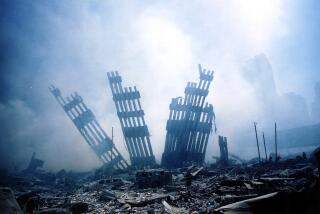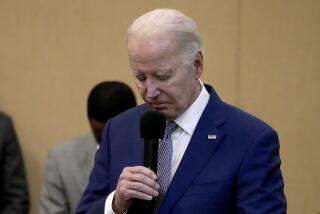5 1/2 Days of High Pressure for Bush, Aides : Drama: How the President decided to send U.S. troops to the Middle East.
WASHINGTON â Five-and-a-half days of nerves, of sleepless nights, of high-stakes maneuvers. From the rumble of Iraqi tanks invading Kuwait to the scream of American jets landing in Saudi Arabia, 5 1/2 days that may yet prove to be the prelude to a wider war.
In Cairo, word came with the dawn. Aides rousted Egyptian President Hosni Mubarak from sleep with news that Iraqâs armor had crossed into Kuwait. âI woke up, and I couldnât believe what was going on,â Mubarak recalled. âI was dazed.â
Across the globe, in Washington, night had fallen. âI was called at 9:45 at home and told to be on alert,â a senior U.S. official said. âWithin half an hour they called back to say all hell had broken loose and to come in and be prepared to spend the night.â
One night became two, then three, then a weekend, then more. On the public record, the conduct of the worldâs first post-Cold War crisis has appeared to be a stately progression of well-planned moves--U.N. resolutions and diplomatic consultations culminating in the most genteel setting possible, the royal palace in Jidda, Saudi Arabia.
There, Monday night, Saudi King Fahd sipped tea as U.S. Defense Secretary Dick Cheney and his Middle East commander, H. Norman Schwarzkopf, presented intelligence data on a massive Iraqi buildup, including possible chemical weapons, poised on the Saudi frontier.
At the close of the two-hour meeting, Cheney said Wednesday, âthe king made the request for the deployment of U.S. forces to the kingdom.â
But for the men and women who lived it--in Washington, London, Cairo, Jidda and Tokyo--the crisis has been a bewildering frenzy of sudden alerts, endless meetings, late-night telephone calls and fear. âEverybodyâs been operating on adrenaline and coffee since Wednesday night,â said one Administration official. Arab leaders were doing no better. Halfway through the period, Yemenâs president checked into a hospital for exhaustion.
No wonder that by the end, President Bush was stumbling over words, almost punchy with fatigue, thanking reporters at a news conference for correcting him after he confused Saudi Arabia with the Soviet Union.
âIâve screwed up a couple of times here,â he said with a tired grin.
For Bush, the Iraqi crisis consumed even his rare moments of relaxation. Saturday afternoon, aides said, the President took a few hours off to play tennis at Camp David, Md., with a couple of weekend guests--visiting pros Pam Shriver and Chris Evert--only to be interrupted by the telephone. It was West German Chancellor Helmut Kohl, calling to tell the President that Europe had agreed to join the United States in cutting off Iraqi oil.
âIâm in a tie breaker. Very crucial time,â the President said. âBut let the record show Iâll take the call.â
Call after call after call. Even for Bush, for whom the phone call is a vital instrument of statecraft, the Iraqi crisis has been a telephonic extravaganza.
The Presidentâs telephone log for the past several days resembles an index of world leaders: Saudi King Fahd, Jordanâs King Hussein, Mubarak, Yemenâs Ali Abdullah Saleh, Fahd again, Turkish President Turgut Ozal, Japanese Prime Minister Toshiki Kaifu, Britainâs Margaret Thatcher, Franceâs Francois Mitterrand, the Sultans of Bahrain, Oman and Dubai, Kohl, Fahd again, King Hussein again, Kaifu again.
For three weeks, those leaders and others had watched Iraqâs Saddam Hussein and wondered about his motives and his plans.
Since mid-July, intelligence officials in the United States and the Middle East had reported ominous signs of Iraqi troop movements near the Kuwaiti border. But when Mubarak confronted Hussein with the evidence, âHe told me, âAbsolutely not.â He told me these were just routine movements and that the troops were 80 kilometers away from the border,â the Egyptian leader said in a nationwide broadcast Wednesday.
âAnd then I asked him another question: Did he intend to attack Kuwait? And he told me no,â Mubarak said.
For a time, world leaders took Saddam Hussein at his word. U.S. officials, for example, allowed Ambassador April Glaspie to go to London for a vacation. In Washington, Deputy National Security Adviser Robert Gates had left town on a hiking trip. President Bushâs main concern was a rapidly collapsing set of budget negotiations with Congress.
But shortly before dawn on Aug. 2--8:14 p.m. on the night of Aug. 1 in Washington--Husseinâs tanks changed all that.
In a large conference room in the basement of the West Wing of the White House, the highly secret Situation Room, word of the invasion arrived almost instantly. A three-person night shift staff examined the evidence, confirmed the attack was genuine and called National Security Adviser Brent Scowcroft.
About 20 minutes later, having driven from his home in suburban Bethesda, Md., to the White House, Scowcroft arrived at the Situation Room, notified Bush of the attack and convened a meeting of the governmentâs crisis management team.
A video conference linked him with officials at the Pentagon, the State Department and CIA headquarters across the Potomac River in Virginia.
As they met, Treasury Deputy Secretary John E. Robson and a team of lawyers arrived at the White House to begin drafting a set of executive orders that would freeze all Iraqi and Kuwaiti assets in the country, denying Iraq the chance to gain control of Kuwaiti wealth--from gold bullion stored at the Federal Reserve Bank of New York to a California-based oil drilling firm.
A few blocks away, on the seventh floor of the State Department, Undersecretary Robert M. Kimmitt assembled a crisis task force. Down the hall, another task force was sifting through news of massacres and civil war in the West African nation of Liberia.
Yet a third task force worried over the end of a 5-day-long hostage drama in Trinidad. In the background, television sets tuned to CNN brought the harried diplomats the latest pictures from the front.
Similar scenes were played out in Rome, where European Community officials met Saturday to hammer out a response to the attack; in Tokyo, where Kaifu on Sunday overruled objections from powerful bureaucrats and joined the U.S.-led campaign to boycott Iraq, and in Moscow, where Soviet officials pondered whether to abandon a long-time Third World ally for the sake of their newly won friendship with the United States.
The strategy began Thursday, in the bucolic setting of a ranch in Coloradoâs high mountain country, where Bush met with Thatcher and hammered out the first allied steps.
The next morning, U.S. intelligence officials delivered their intelligence assessment to Bush. Saddam Hussein had struck Kuwait out of a desire to become âthe dominant power in the Middle Eastâ and gain âcontrol over OPEC,â they said. Control over the Organization of Petroleum Exporting Countries would give Hussein a hold on the economic jugular of the industrialized world, they warned.
At an early morning meeting of Bushâs top security advisers, there was âan unspoken consensusâ that the United States had âa major stakeâ in thwarting Husseinâs ambition, a senior White House official recalled. Bush gave his advisers 24 hours to prepare military options. Later that day, in a meeting of Western ambassadors, Kimmitt asked U.S. allies to send naval forces to the Persian Gulf.
At Camp David last Saturday morning, top military officials briefed Bush on his choices. With intelligence showing Iraqi troops massing within a few miles of the Saudi frontier, the United States âneeded to have a defensive posture inside Saudi Arabiaâ if Hussein were to be stopped, the military leaders told him.
Later that day, Scowcroft spoke with the Saudi ambassador, Prince Bandar, son of Saudi Arabiaâs defense minister and nephew of the king. A few hours after that, Fahd and Bush spoke. The conversations were conducted in carefully modulated diplomatic parlance, but the message was clear--the Saudis were frightened by Iraq and were ready, after years of resistance, to let American troops enter their kingdom.
Within hours, Cheney was on his way to Jidda.
As he flew, Joseph C. Wilson, the chief U.S. diplomat in Baghdad, met with Hussein. It was a tense and difficult meeting. The Iraqi dictator was bellicose and defiant. The die had been cast, a senior U.S. official said. Whatever comes next, âwe knew there was no going back.â
Times staff writers Kim Murphy, in Cairo, Melissa Healy, Tom Redburn, Douglas Jehl and Geraldine Baum, in Washington, and William Rempel, in Los Angeles, contributed to this story.
More to Read
Get the L.A. Times Politics newsletter
Deeply reported insights into legislation, politics and policy from Sacramento, Washington and beyond. In your inbox three times per week.
You may occasionally receive promotional content from the Los Angeles Times.











